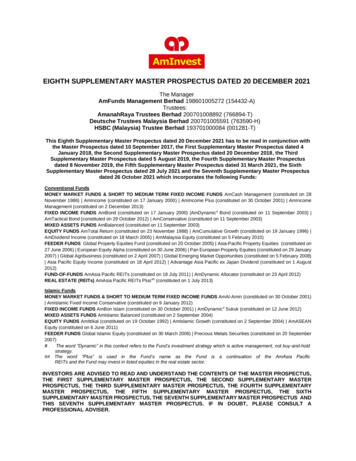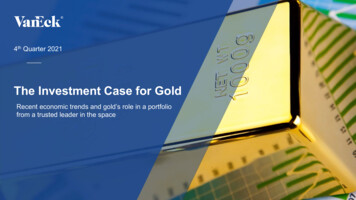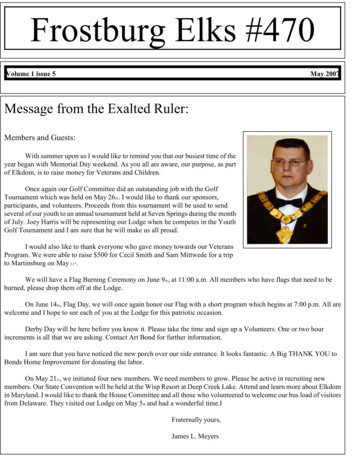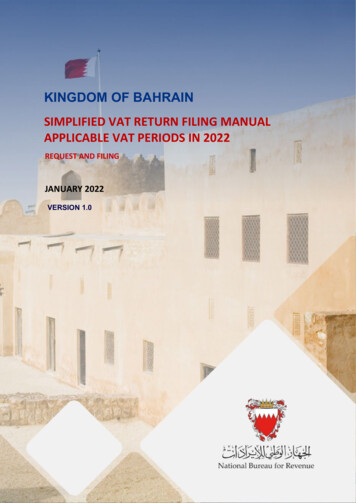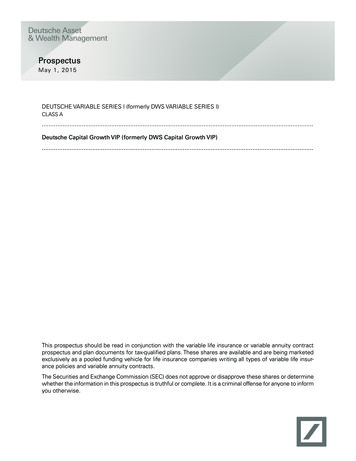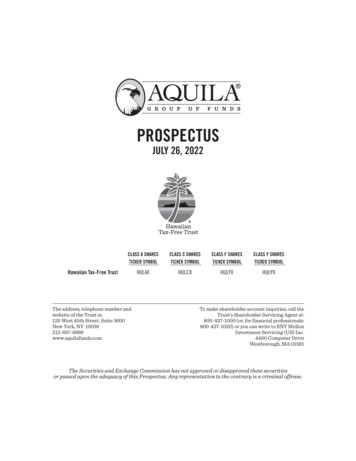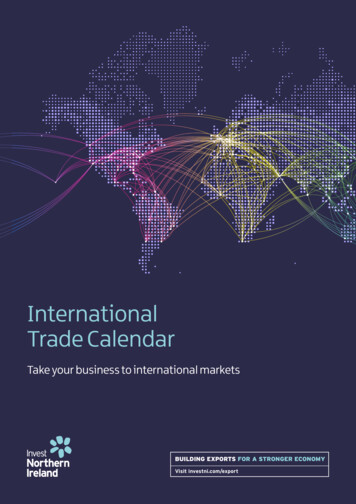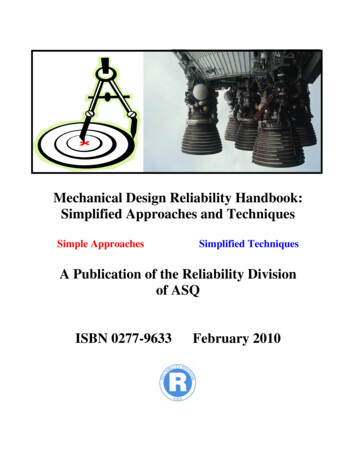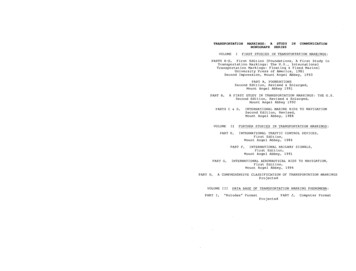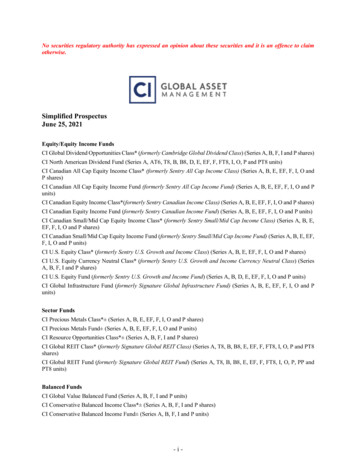
Transcription
No securities regulatory authority has expressed an opinion about these securities and it is an offence to claimotherwise.Simplified ProspectusJune 25, 2021Equity/Equity Income FundsCI Global Dividend Opportunities Class* (formerly Cambridge Global Dividend Class) (Series A, B, F, I and P shares)CI North American Dividend Fund (Series A, AT6, T8, B, B8, D, E, EF, F, FT8, I, O, P and PT8 units)CI Canadian All Cap Equity Income Class* (formerly Sentry All Cap Income Class) (Series A, B, E, EF, F, I, O andP shares)CI Canadian All Cap Equity Income Fund (formerly Sentry All Cap Income Fund) (Series A, B, E, EF, F, I, O and Punits)CI Canadian Equity Income Class*(formerly Sentry Canadian Income Class) (Series A, B, E, EF, F, I, O and P shares)CI Canadian Equity Income Fund (formerly Sentry Canadian Income Fund) (Series A, B, E, EF, F, I, O and P units)CI Canadian Small/Mid Cap Equity Income Class* (formerly Sentry Small/Mid Cap Income Class) (Series A, B, E,EF, F, I, O and P shares)CI Canadian Small/Mid Cap Equity Income Fund (formerly Sentry Small/Mid Cap Income Fund) (Series A, B, E, EF,F, I, O and P units)CI U.S. Equity Class* (formerly Sentry U.S. Growth and Income Class) (Series A, B, E, EF, F, I, O and P shares)CI U.S. Equity Currency Neutral Class* (formerly Sentry U.S. Growth and Income Currency Neutral Class) (SeriesA, B, F, I and P shares)CI U.S. Equity Fund (formerly Sentry U.S. Growth and Income Fund) (Series A, B, D, E, EF, F, I, O and P units)CI Global Infrastructure Fund (formerly Signature Global Infrastructure Fund) (Series A, B, E, EF, F, I, O and Punits)Sector FundsCI Precious Metals Class* (Series A, B, E, EF, F, I, O and P shares)CI Precious Metals Fund (Series A, B, E, EF, F, I, O and P units)CI Resource Opportunities Class* (Series A, B, F, I and P shares)CI Global REIT Class* (formerly Signature Global REIT Class) (Series A, T8, B, B8, E, EF, F, FT8, I, O, P and PT8shares)CI Global REIT Fund (formerly Signature Global REIT Fund) (Series A, T8, B, B8, E, EF, F, FT8, I, O, P, PP andPT8 units)Balanced FundsCI Global Value Balanced Fund (Series A, B, F, I and P units)CI Conservative Balanced Income Class* (Series A, B, F, I and P shares)CI Conservative Balanced Income Fund (Series A, B, F, I and P units)-i-
CI U.S. Equity & Income Fund (formerly Sentry U.S. Monthly Income Fund) (Series A, AH, B, E, EF, F, FH, I, IH,O, P and PH units)Fixed-income FundsCI Money Market Class* (Series A, B, F, I and P shares)CI Corporate Bond Class* (formerly Signature Corporate Bond Class) (Series A, B, E, EF, F, I, O and P shares)CI High Yield Bond Class* (formerly Signature High Yield Bond Class) (Series A, B, E, EF, F, I, O and P shares)Personal Pension PortfoliosCI Balanced Income Personal Portfolio* (formerly Sentry Balanced Income Portfolio) (Series A, T5, T7, B, B5, B7,F, FT5, FT7, I and P shares)CI Conservative Income Personal Portfolio* (formerly Sentry Conservative Income Portfolio) (Series A, T5, T7, B,B5, B7, F, FT5, FT7, I and P shares)CI Defensive Income Personal Portfolio* (formerly Sentry Defensive Income Portfolio) (Series A, T5, B, B5, F, FT5,I and P shares)CI Growth & Income Personal Portfolio* (formerly Sentry Growth and Income Portfolio) (Series A, T4, T6, B, B4,B6, F, FT4, FT6, I and P shares)CI Growth Personal Portfolio* (formerly Sentry Growth Portfolio )(Series A, T4, T6, B, B4, B6, F, FT4, FT6, I andP shares)Equity PoolsCI Canadian Equity Income Private Pool Class* (Series A, F and P shares)CI Canadian Equity Income Private Trust (Series I units)CI Global Equity Income Private Pool Class* (Series A, F and P shares)CI International Equity Income Private Pool Class* (Series A, F and P shares)CI International Equity Income Private Trust (Series I units)CI U.S. Equity Currency Neutral Private Pool Class*(formerly Sentry U.S. Equity Income Currency Neutral PrivatePool Class) (Series A, F and P shares)CI U.S. Equity Private Pool Class* (formerly Sentry U.S. Equity Income Private Pool Class) (Series A, F and P shares)CI U.S. Equity Private Trust (formerly Sentry U.S. Equity Income Private Trust) (Series I units)Sector PoolsCI Energy Private Trust (Series I units)CI Global Infrastructure Private Trust (Series I units)CI Global Real Estate Private Trust (Series I units)CI Precious Metals Private Trust (Series I units)Balanced PoolsCI Balanced Yield Private Pool Class* (Series A, F and P shares)CI Global Balanced Yield Private Pool Class* (Series A, F and P shares)Fixed-Income PoolsCI Canadian Core Fixed Income Private Trust (Series I units)- ii -
CI Global Core Fixed Income Private Trust (Series I units)CI Global High Yield Fixed Income Private Trust (Series I units)CI Global Investment Grade Private Pool Class* (Series A, F and P shares)(collectively, the “Funds”)*A class of shares of Sentry Corporate Class Ltd. Former name began with “Sentry” (now replaced with “CI”)- iii -
TABLE OF CONTENTSINTRODUCTION . 1PART A: WHAT IS A MUTUAL FUND AND WHAT ARE THE RISKS OF INVESTING IN AMUTUAL FUND? . 3ORGANIZATION AND MANAGEMENT OF THE FUNDS . 14PURCHASES, SWITCHES AND REDEMPTIONS. 16OPTIONAL SERVICES . 31FEES AND EXPENSES . 34DEALER COMPENSATION . 56INCOME TAX CONSIDERATIONS FOR INVESTORS. 63WHAT ARE YOUR LEGAL RIGHTS? . 68PART B: SPECIFIC INFORMATION ABOUT EACH OF THE MUTUAL FUNDS DESCRIBEDIN THIS DOCUMENT. 69Introduction. 69CI Global Dividend Opportunities Class . 74CI North American Dividend Fund . 78CI Canadian All Cap Equity Income Class. 82CI Canadian All Cap Equity Income Fund . 86CI Canadian Equity Income Class. 90CI Canadian Equity Income Fund . 94CI Canadian Small/Mid Cap Equity Income Class . 97CI Canadian Small/Mid Cap Equity Income Fund. 101CI U.S. Equity Class. 105CI U.S. Equity Currency Neutral Class . 109CI U.S. Equity Fund . 113CI Global Infrastructure Fund . 117CI Precious Metals Class . 121CI Precious Metals Fund . 125CI Resource Opportunities Class . 128CI Global REIT Class. 131CI Global REIT Fund . 135CI Global Value Balanced Fund . 139CI Conservative Balanced Income Class . 143CI Conservative Balanced Income Fund . 147CI U.S. Equity & Income Fund. 150CI Money Market Class. 154CI Corporate Bond Class . 156CI High Yield Bond Class . 160CI Balanced Income Personal Portfolio. 164CI Conservative Income Personal Portfolio. 168CI Defensive Income Personal Portfolio . 172- i-
CI Growth & Income Personal Portfolio . 176CI Growth Personal Portfolio . 180CI Canadian Equity Income Private Pool Class . 184CI Canadian Equity Income Private Trust . 187CI Global Equity Income Private Pool Class . 190CI International Equity Income Private Pool Class . 193CI International Equity Income Private Trust . 197CI U.S. Equity Currency Neutral Private Pool Class . 200CI U.S. Equity Private Pool Class . 204CI U.S. Equity Private Trust . 208CI Energy Private Trust . 211CI Global Infrastructure Private Trust . 214CI Global Real Estate Private Trust . 217CI Precious Metals Private Trust . 220CI Balanced Yield Private Pool Class . 223CI Global Balanced Yield Private Pool Class . 227CI Canadian Core Fixed Income Private Trust . 231CI Global Core Fixed Income Private Trust . 234CI Global High Yield Fixed Income Private Trust . 237CI Global Investment Grade Private Pool Class . 240- ii-
INTRODUCTIONHow to use this Simplified ProspectusThis Simplified Prospectus provides important information to help you make informed investment decisions and tohelp you understand your rights as an investor.This document is divided into two parts: Part A contains general information about mutual funds and the risks of investing in mutual funds. It alsocontains information about how to buy and sell securities of the Funds, and the fees involved, as well asincome tax considerations and the entities that manage the operations of the Funds. Part B contains specific information about each of the Funds that appear on the front cover.TermsWe have used personal pronouns in this document whenever possible to make it easier to read and understand. “You” means an investor or potential investor. “We”, “us” and “our” mean CI Investments Inc. or CI Global Asset Management, a registered business name ofCI Investments Inc.We also use the terms “Manager” and “Trustee” to refer to CI Investments Inc. or CI Global Asset Management, aregistered business name of CI Investments Inc.The term “financial advisor” means the registered representative who advises you on your investments. The term“dealer” means the company where your financial advisor works.The term “Pools” or “Pool” when used herein refers to those mutual funds on the front cover of this document foundunder the following headings: Equity Pools, Sector Pools, Balanced Pools, Fixed-Income Pools.When we capitalize “Funds” or “Fund”, we are referring to the mutual funds (including the Pools) that appear on thefront cover of this document, or any one of them. When we do not capitalize “fund”, we are referring to mutual fundsin general.The term “CI Funds” or “CI Fund” when used herein refers to mutual funds managed by CI Investments Inc., whichare qualified for distribution under a separate simplified prospectus.A final note on terms: As you review this Simplified Prospectus you will notice that additional terms are definedwithin the document. Each of these terms, when subsequently used in this document, incorporates the definition foundat that term’s initial use.Further InformationYou can obtain more information about each Fund in the following documents: the Annual Information Form; the most recently filed Fund Facts documents; the most recently filed audited annual financial statements;- 1-
any unaudited interim financial statements filed after those annual financial statements; the most recently filed annual management report of fund performance; and any interim management reports of fund performance filed after the annual management report of fundperformance.All of these documents are incorporated by reference into this Simplified Prospectus. This means that they legallyform part of this document, just as if they were printed as part of it.You can get a copy of any or all of these documents, at your request, and at no cost, by calling us toll free at 1-800792-9355, by sending us an e-mail at service@ci.com, or by asking your financial advisor.These documents are also available on our website at www.ci.com and may also be found, together with otherinformation about the Funds, on the System for Electronic Document Analysis and Retrieval (SEDAR) website atwww.sedar.com.- 2-
PART A: WHAT IS A MUTUAL FUND ANDWHAT ARE THE RISKS OF INVESTING IN A MUTUAL FUND?What is a mutual fund?A mutual fund is a pool of investments owned by a group of investors with similar investment objectives. Professionalportfolio managers use the money contributed by investors to purchase securities for the fund’s investment portfolio.When you invest in a fund, you are a “securityholder”. You share with other securityholders the fund’s income,certain expenses, and the gains and losses the fund makes on its investments. Your share of the gains and losses arein proportion to the number of securities you own.Types of mutual fundsWe offer our Funds in two different structures: “Corporate Funds” and “Trust Funds”. Either structure allows youto pool your savings with other investors with similar investment objectives. Each Trust Fund operates as a separate investment trust. When you invest in a Trust Fund, you are buying units. Corporate Funds are set up differently. Each Corporate Fund, as noted with an asterisk on the front cover, is aseparate class of shares of Sentry Corporate Class Ltd. (“Sentry Corp.”), which is a mutual fund corporationwith common shares and mutual fund shares. When you invest in one of our Corporate Funds, you are buyingmutual fund shares in Sentry Corp.We refer to both units and shares as securities in this Simplified Prospectus.There are also other differences between the two structures: An investment trust has its own investment objectives. A mutual fund corporation may have more than one class of shares. Each class has its own investmentobjectives. Investment trusts are separate taxpayers. Mutual fund corporations are taxed as a single entity. A multi-class mutual fund corporation, such asSentry Corp., must consolidate the income, capital gains, expenses and capital losses from all its classesto determine the amount of tax payable by it. An investment trust makes taxable distributions of net income, including net taxable capital gains, to itsunitholders. A mutual fund corporation pays ordinary dividends or capital gains dividends to its shareholders.Some Corporate Funds have the same or similar investment objectives as a Trust Fund. As a result, you mayhave the option to invest in either a Corporate Fund or equivalent Trust Fund depending on which is more suitableto your investment program. You should obtain advice from your tax and financial advisors about which structureyou should invest in. There are different income tax considerations related to investments in Trust Funds andCorporate Funds. You will find more information in the section “Income Tax Considerations for Investors”.- 3-
What do mutual funds invest in?Equity and debt securitiesMutual funds can invest in equity securities, which may earn dividends, or in debt securities, which earn interest. Anequity security is a stock or a share in a company or a unit of a royalty or income trust. Debt securities include bondsand money market instruments such as treasury bills and certificates of deposit. Debt securities may be issued bygovernments or companies. Some of the Funds may invest in convertible securities, which are often debt securitiesthat can be converted to equity securities.DerivativesA fund can also invest in derivatives. A derivative is essentially a contract, the value of which is dependent upon thevalue of another investment such as a stock, bond, currency or market index.Underlying funds/underlying poolsMutual funds can also invest in the securities of other funds, which are then referred to as underlying funds orunderlying pools, as applicable. How much a Fund or Pool invests in underlying funds or underlying pools, and thetypes of funds or pools it invests in, may vary. Investing in underlying funds or underlying pools allows us to aggregateor consolidate assets in a manner that is often more efficient for investors, and generally results in lower expenses.Many of the Corporate Funds invest only in the Trust Fund that has the same investment objective. This avoids muchof the expense of managing two separate investment portfolios and can help enhance returns.What is a series?The Funds offer securities in more than one series. This kind of multi-series structure recognizes that differentinvestors may require different investment advice and service. Each series of a Fund derives its value from the sameportfolio, and shares the same investment objective and strategies, but may charge different fees and incur differentexpenses.Collectively, the Funds are currently offered in a variety of series, including Series A, Series AH, Series B, Series D,Series E, Series EF, Series F, Series FH, Series I, Series IH, Series O, Series P, Series PH and Series PP. In addition,some of the Funds also offer certain series with a targeted fixed monthly distribution per security, including SeriesT4, Series T5, Series T6, Series T7 and Series T8 (collectively, referred to as “Series T”); Series B4, Series B5, SeriesB6, Series B7 and Series B8 (collectively, referred to as “Series BT”); Series FT4, Series FT5, Series FT6, Series FT7and Series FT8 (collectively, referred to as “Series FT”); Series PT8 and Series AT6. Each Fund is not necessarilyavailable in each of these series. As an investor, you need to determine which series is the best match for you. Pleaseconsult your financial advisor when considering which series is the best option for you. The particular series availablefor each Fund are found on the front cover of this document and in Part B of each Fund.There is more information on how series differ from one another in the section “Purchases, Switches andRedemptions”.The series NAV of a mutual fundThe series net asset value (“NAV”) of a fund is determined by taking the series’ proportionate share of the marketvalue of each security in the fund’s portfolio, adding its proportionate share of all other assets and subtracting theseries’ liabilities and its proportionate share of common liabilities of the fund attributable to that series. The result isthe series NAV of the fund.- 4-
Series NAV per securitySince each series of a Fund has different costs and liabilities, the series NAV per security is calculated separately foreach series.We calculate the series NAV per security for each Fund by taking that series’ NAV, determined as described herein,then dividing that number by the total number of securities of that series that are outstanding.The series NAV per security for each Fund is calculated at the end of each business day. A business day, as used inthis Simplified Prospectus, means any day in which the Toronto Stock Exchange is open for business. You can findmore information about the series NAV per security in the section “Purchases, Switches, and Redemptions”.General investment risksFunds may own different types of investments – for example, stocks, bonds, derivatives or short-term securities,depending on the Fund’s investment objective and strategies. The value of these investments changes from day to daydue to changes in, among other things, interest rates, economic conditions, and news related to markets or companies.As a result, the value of a Fund’s securities may go up or down, and the value of your investment in a Fund may bemore or less when you redeem it than when you purchased it.No part of your investment in a Fund is guaranteed. Unlike bank accounts or guaranteed investment certificates, mutualfund securities are not covered by the Canada Deposit Insurance Corporation or any other government deposit insurer.Under exceptional circumstances, a Fund may suspend redemptions. See the section “Suspension of redemptionrights” for more information.Below, we review in alphabetical order, some of the specific risks that can affect the value of your investment in aFund. In Part B of this document, we describe each of the Funds listed on the front cover and identify which risksapply to each Fund.Each Fund is subject to “changes in legislation risk”, “cyber security risk”, “large redemption risk”, “market risk”,“operational risk”, “series risk”, “securities lending risk”, “tax risk” and “underlying fund risk” (as described below).Each Fund, other than money market funds, is also subject to “exchange-traded fund risk”, “currency risk”, “derivativerisk”, “foreign investment risk”, “liquidity risk”, “short selling risk” and “withholding tax risk”. Each Corporate Fundis also subject to “share series risk”. In addition, all Series T, BT, FT, PT8 and AT6 securities have “capital depletionrisk” (as described below).Capital depletion riskSome Funds and/or some series of a Fund may make distributions comprised in whole or in part, of return of capital.A return of capital distribution is a return of a portion of an investor’s original investment and may, over time, resultin the return of the entire amount of the original investment to the investor. This distribution should not be confusedwith yield or income generated by a Fund. Return of capital distributions that are not reinvested will reduce the NAVof the Fund, which could reduce the Fund’s ability to generate future income. You should not draw any conclusionsabout the Fund’s investment performance from the amount of this distribution. In respect of Series T, BT, FT, PT8and AT6 securities, each applicable Fund has a policy to make monthly distributions of a return of capital tosecurityholders of such series, so long as there is sufficient capital attributable to the relevant series. On the shares ofa Corporate Fund, return of capital can only be distributed to the extent that there is a positive balance in the paid-upcapital account of the series on which the distribution is made. To the extent that the balance in the capital accountbecomes, or is at risk of becoming, zero, monthly distributions may be reduced or discontinued without prior notice.For more information on the tax implications of return of capital distributions, please refer to the section entitled“Income Tax Considerations for Investors”.- 5-
Changes in legislation riskThere can be no assurance that tax, securities and other laws or the interpretation and application of such laws bycourts or government authorities will not be changed in a manner which adversely affects a Fund’s unitholders orshareholders.Commodity riskSome Funds may invest directly or indirectly in commodities, or gain exposure to commodities by investing incompanies engaged in commodity-focused industries or by using exchange-traded funds. Commodity prices canfluctuate significantly in short time periods, which will have a direct or indirect impact on the value of the Fund.Commodity prices can change as a result of a number of factors including supply and demand, government andregulatory matters, speculation, international monetary and political factors, central bank activity and changes ininterest rates and currency values. Direct investments in bullion may generate higher transaction and custody costs.Concentration riskSome Funds hold significant investments in a few companies, rather than investing the Fund’s assets across a largenumber of companies. In some cases, more than 10% of the net assets of a Fund may be invested in securities of asingle issuer as a result of appreciation in value of such investment and/or the liquidation or decline in value of otherinvestments. The investment portfolios of these Funds are less diversified, and therefore are potentially subject tolarger changes in value than mutual funds which hold more broadly-diversified investment portfolios.Credit riskWhen a company or government issues a fixed income security, it promises to pay interest and repay a specifiedamount on the maturity date. Credit risk is the risk that the company or government will not live up to that promise.Credit risk is lowest among issuers that have good credit ratings from recognized credit rating agencies. The riskiestfixed income securities are those with a low credit rating or no credit rating at all. These securities usually offer higherinterest rates to compensate for the increased risk.Currency riskAs a portion of a Fund’s portfolio may be invested in securities traded in currencies other than the base currency inwhich the Fund or a Fund’s series of securities is denominated (“foreign currencies”), the net asset value of the Fundor the series of securities, when measured in the base currency in which the Fund or series of securities is denominated,will, to the extent this has not been hedged against, be affected by changes in the value of the foreign currenciesrelative to the base currency. For example, if the U.S. dollar falls in value relative to the Canadian dollar, a U.S. dollardenominated investment will be worth less for a Fund or series of a Fund based in Canadian dollars. On the otherhand, if the U.S. dollar rises in value relative to the Canadian dollar, a U.S. dollar-denominated investment will beworth more for a Fund or a series of a Fund based in Canadian dollars.Cyber security riskWith the increased use of technologies, such as the Internet, to conduct business, the Funds are susceptible tooperational, information security, and related risks through breaches in cyber security. In general, cyber incidents canresult from deliberate attacks or unintentional events. Cyber-attacks include, but are not limited to, gainingunauthorized access to digital systems (e.g. through “hacking” or malicious software coding) for purposes ofmisappropriating assets or sensitive information, corrupting data, or causing operational disruption. Cyber-attacksmay also be carried out in a manner that does not require gaining unauthori
formerly Sentry U.S. Growth and Income Currency Neutral Class) (Series A, B, F, I and P shares) CI U.S. Equity Fund (formerly Sentry U.S. Growth and Income Fund) (Series A, B, D, E, EF, F, I, O and P units) CI Global Infrastructure Fund (formerly Signature Global Infrastructure Fund)
